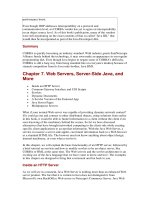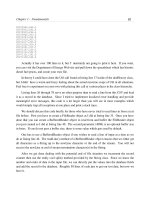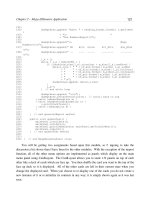About Java and xBaseJ- P4
Bạn đang xem bản rút gọn của tài liệu. Xem và tải ngay bản đầy đủ của tài liệu tại đây (1.15 MB, 20 trang )
Chapter 1 – Fundamentals
if (MAX_NAME_LEN > p.getLength())
curr_width = MAX_NAME_LEN
else
curr_width = p.getlength();
None of you really wanted me to use “if ” statements inside of switch cases, though if you
work in the real world you will see them quite often. As a general rule, you are not in trouble
until your nesting gets more than 3 levels deep.
The display logic for each column isn't complex, but might require a bit of explanation.
MAX_NAME_LEN is defined to be eleven because ten used to be the maximum length for a
column name under most xBASE flavors, and eleven ensures we will have at least one trailing
space. When displaying a data column, I want this example to be at least wide enough to display
the name. (One thing which really annoys me about most spreadsheet applications is they size
columns to the data size, even when the column is a Boolean.) When we are dealing with a
character field I use the “” in the format string to leftjustify the output. Most everything else I
simply let slam against the right. I don't bother formatting date values in this example. You can
write thousands of lines of code formatting dates in every format imaginable, and still somebody
will want the date formatted differently.
testShowMe.java
1) public class testShowMe {
2)
3) public static void main(String args[]){
4) showMe s = new showMe();
5)
6) s.showDBF("class.dbf");
7) System.out.println( "\n");
8) s.showDBF( "teacher.dbf");
9) System.out.println( "\n");
10) System.out.println( " Entire class.dbf");
11) s.dump_records( "class.dbf");
12) System.out.println( "\n");
13) System.out.println( " Records 2 and 3 from class.dbf");
14) s.dump_records( "class.dbf", 2, 3);
15) System.out.println( "\n");
16) System.out.println( " First record from teacher.dbf");
17) s.dump_records( "teacher.dbf", 1);
18)
19) } // end main method
20)
21) } // end class testShowMe
The test module simply displays various things from the two DBF files created by the sample
programs which are posted on the xBaseJ Web site. I have shown you the program which creates
the class.dbf file in this book. We don't really have any need to cover the teacher.dbf, but it is
created by example3.java found in the xBaseJ distribution or on the SourceForge site.
61
Chapter 1 Fundamentals
roland@logikaldesktop:~/fuelsurcharge2$ source ./env1
roland@logikaldesktop:~/fuelsurcharge2$ javac showMe.java
jroland@logikaldesktop:~/fuelsurcharge2$ javac testShowMe.java
roland@logikaldesktop:~/fuelsurcharge2$ java testShowMe
class.dbf has:
3 records
7 fields
FIELDS
Name Type Length Decimals
---------------------------------------------------
CLASSID C 9 0
CLASSNAME C 25 0
TEACHERID C 9 0
DAYSMEET C 7 0
TIMEMEET C 4 0
CREDITS N 2 0
UNDERGRAD L 1 0
teacher.dbf has:
3 records
4 fields
FIELDS
Name Type Length Decimals
---------------------------------------------------
TEACHERID C 9 0
TEACHERNM C 25 0
DEPT C 4 0
TENURE L 1 0
Entire class.dbf
CLASSID CLASSNAME TEACHERID DAYSMEET TIMEMEET CREDITS UNDERGRAD
----------- ------------------------- ----------- ----------- ----------- ----------- -----------
JAVA501 JAVA And Abstract Algebra 120120120 NNYNYNN 0930 6 F
JAVA10200 Intermediate JAVA 300020000 NYNYNYN 0930 3 T
JAVA10100 Introduction to JAVA 120120120 NYNYNYN 0800 3 T
Records 2 and 3 from class.dbf
CLASSID CLASSNAME TEACHERID DAYSMEET TIMEMEET CREDITS UNDERGRAD
----------- ------------------------- ----------- ----------- ----------- ----------- -----------
JAVA10200 Intermediate JAVA 300020000 NYNYNYN 0930 3 T
JAVA10100 Introduction to JAVA 120120120 NYNYNYN 0800 3 T
First record from teacher.dbf
TEACHERID TEACHERNM DEPT TENURE
----------- ------------------------- ----------- -----------
120120120 Joanna Coffee 0800 T
When I paste the output into this book layout, we end up with some wrapping problems due
to the width restrictions of the page. I had to shrink the font so it would fit on a line for you. As
you can see, the output is nicely formatted. Once I get past displaying all of the columns on each
database, I display the entire contents of the class.dbf file. This first display allows us to verify
that the second display, restricting output to the second and third record, actually worked. The
last test is simply displaying only the first record from the teacher.dbf file.
62
Chapter 1 – Fundamentals
You will squirrel away the showMe.java source file in your toolbox. You might even join the
xBaseJ project team and fix a few things with the library, then clean this example up. If you were
paying attention reading the chart starting on page 20 you also noted that the xBASE universe
contains a lot of data types which simply aren't supported by this library. Autoincrement (+)
would be a nice addition, but probably not the first you should tackle since doing so would most
likely require that you understand more about the header record. The Datetime (T) column type
would be a welcome addition. When you get into more transactionoriented applications the field
becomes extremely important. Double (O) and Integer (I) would be interesting for those who
believe they are Uber geeks and capable of getting those datatypes to be correctly stored
no
matter what platform xBaseJ is running on
.
I must warn you that I never tested the Picture (P) data type. I had no desire to create a
database and store images in it. More importantly, I had no desire to figure out what image types
(JPEG, BMP, PNG, etc.) were actually supported. I know
why
pictures were added, but I never
played much in that world. Images were added so store catalog/inventory records could contain a
memo field with the item description, and a picture field with an image of the item. If you have
an eBay store with around 100 items, this is fine. If you are running a serious business or think it
might
turn into a serious business, you should really start with a relational database and bolt on
what you need later. (Remember that 2GB data file limit? We always
say
the 4GB file limit was
imposed by FAT32, but have you checked the header file and 10 digit tag algorithm of a memo
file to ensure it isn't limited by an unsigned 32bit integer as well?)
1.101.10
1.101.10
1.101.10
Programming Assignment 3Programming Assignment 3
Programming Assignment 3Programming Assignment 3
Programming Assignment 3Programming Assignment 3
Modify the last two dump_records() calls in testShowMe.java to dump only the second record
of class.dbf and only the third record respectively. This is a very simple assignment designed to
build confidence in the boundary logic of the dump_records() method.
Create your own version of testShowMe.java which operates on the teacher.dbf file. I haven't
provided you the source to create the teacher.dbf file, so you will need to pull it down from the
xBaseJ project site.
63
Chapter 1 Fundamentals
1.11
1.111.11
1.111.11
1.11
Descending Indexes and Index Lifespan
Descending Indexes and Index LifespanDescending Indexes and Index Lifespan
Descending Indexes and Index LifespanDescending Indexes and Index Lifespan
Descending Indexes and Index Lifespan
You have already seen how indexes can be useful when it comes to keeping data in a sorted
order. Even if the data isn't physically sorted, the index allows you to retrieve it in the order you
want. We haven't done much with direct record access yet, but you probably understand it is
another benefit of having an index.
One extremely useful type of index is the descending index. You will find this type of index
used for many different things in a production world. Some inventory systems use a descending
index for product keys in their inventory files. Let's say you run a gas station with a small
convenience store in it. You add new products to your inventory file based on a 4character
product category and a 10digit item number, then you assign it some kind of barcode scan value.
You need to keep the categories split out for various tax reasons. As long as the item number is
unique, you don't personally care what it is. You might have some data looking like this:
TOBA0009876543 CIG GENERIC MENTH BOX
TOBA0009876542 CIG GENERIC MENTH
TOBA0009876541 CIG GENERIC
DARY0000056432 QUART MILK 2%
DARY0000056431 QUART MILK WHOLE
DARY0000056430 QUART MILK CHOC 2%
Whenever you added a new product, you would only need to know what category to put it
under and your system could automatically calculate the next item number by using the category
against the descending key. Given the data above, the first hit for “ TOBA” would return
“TOBA00009876543” which would let our routine add one to the numeric portion for a new key.
Likewise, “DARY” would return “DARY0000056432 .” (Yes, dary is really spelled dairy, but not
in oldschool inventoryspeak.)
xBaseJ didn't provide us with descending indexes. This was actually a flaw many early
xBASE packages had. A lot of useless data ended up getting stored in production data files trying
to work around this problem. It was not uncommon to find bogus numeric columns which
contained the result of a field of all 9's with another column (usually a date) subtracted from it. It
would be this bogus column, not the actual column, which would be made part of a key.
MYDT MYDTDS
19990801 80009198
19550401 80449598
19200101 80799898
As you can see, the newest date has the smallest value, which makes it the first key in an
ascending key list. Developers dealing with character fields wrote functions and subroutines
which would subtract the string from a string of all Z's to achieve this same sort order.
64
Chapter 1 – Fundamentals
If you are someone who has never had a machine slower than 2Ghz or less than 2GB of
RAM, you probably have a lot of trouble understanding why descending indexes are so important.
You will happily use the startBottom() and readPrev() methods provided by xBaseJ performing
needless I/O on nearly onethird of the database looking for that one particular record. Those of
us who grew up in the PC era understand the need completely. We used to have to wait multiple
seconds for each record to be retrieved from that 10MB fullheight hard drive. Even if they deny
it, we all know that Seagate added that chirping cricket sound and flashing light simply to keep
people entertained while they were desperately trying to find the disk block they were interested
in.
While you can find the record you are looking for by brute force, index searching is much
less resource intensive. I'm not going to print the source for find_entry( NodeKey, Node, int) of
the NDX.java file in this book. It's some pretty intense code. It's not difficult to read, just one of
those routines where you have to wrap your mind around it at one sitting, and not get up to go to
the bathroom until you have found what you intended to find. All you need to know is that it
relies on a bunch of other classes to walk the nodes in the Btree looking for your key value.
Ultimately, it is this method which gets called from the DBF class whenever you call find(“ abc” ).
(Assuming, of course, that you are using NDX instead of MDX as your indexed file.)
doeHistory.java
1) import java.io.*;
2) import java.util.*;
3) import org.xBaseJ.*;
4) import org.xBaseJ.fields.*;
5) import org.xBaseJ.Util.*;
6) import org.xBaseJ.indexes.NDX;
7)
8) public class doeHistory {
9)
10) // variables used by the class
11) //
12) private DBF aDB = null;
13)
14) // fields
15) public DateField effectiveDT = null;
16) private NumField effectiveDTDesc = null;
17) public NumField fuelPrice = null;
18)
19) // file names
20) public final String DEFAULT_DB_NAME = "doehst.dbf";
21) public final String DEFAULT_K0_NAME = "doe_k0.ndx";
22) public final String DEFAULT_K1_NAME = "doe_k1.ndx";
23)
24) // work variables
25) private boolean continue_flg = true;
26) private boolean dbOpen = false;
27)
28) // result codes
29) public static final int DOE_SUCCESS = 1;
30) public static final int DOE_DUPE_KEY = 2;
65
Chapter 1 Fundamentals
31) public static final int DOE_KEY_NOT_FOUND = 3;
32) public static final int DOE_FILE_OPEN_ERR = 4;
33) public static final int DOE_DEVICE_FULL = 5;
34) public static final int DOE_NO_CURRENT_REC = 6;
35) public static final int DOE_DELETE_FAIL = 7;
36) public static final int DOE_GOTO_FAIL = 8;
37) public static final int DOE_DB_CREATE_FAIL = 9;
38) public static final int DOE_INVALID_DATA = 10;
39) public static final int DOE_END_OF_FILE = 11;
40)
41) //;;;;;;;;;;;;;;;;;;;;;;;;;;;;;;;;;;;;;;;;
42) // Method to add a record
43) // This method assumes you have values already loaded
44) //
45) // Many different flavors exist to accommodate what the
46) // user may have for input
47) //;;;;;;;;;;;;;;;;;;;;;;;;;;;;;;;;;;;;;;;;
48) public int add_record() {
49) int ret_val = DOE_SUCCESS;
50) long x;
51)
52) try {
53) x = 99999999 - Long.parseLong(effectiveDT.get());
54) } catch (NumberFormatException n) {
55) x = 99999999;
56) } // end catch NumberFormatException
57)
58) //
59) // stop the user from doing something stupid
60) //
61) if (!dbOpen)
62) return DOE_FILE_OPEN_ERR;
63)
64) try {
65) effectiveDTDesc.put( x);
66) aDB.write();
67) } catch ( xBaseJException j){
68) ret_val = DOE_DUPE_KEY;
69) System.out.println( j.getMessage());
70) } // end catch
71) catch( IOException i){
72) ret_val = DOE_DEVICE_FULL;
73) } // end catch IOException
74)
75)
76) return ret_val;
77) } // end add_record method
78)
79) public int add_record( String d, String f) {
80) int ret_val = DOE_SUCCESS;
81)
82) try {
83) effectiveDT.put( d);
84) fuelPrice.put( f);
85) } catch ( xBaseJException j){
86) if (j.getMessage().indexOf( "Invalid length for date Field") > -1)
87) ret_val = DOE_INVALID_DATA;
88) else
89) ret_val = DOE_DUPE_KEY;
90) } // end catch
91)
92)
93) if (ret_val == DOE_SUCCESS)
66
Chapter 1 – Fundamentals
94) return add_record();
95) else
96) return ret_val;
97) }
98)
99) public int add_record( Date d, float f) {
100) int ret_val = DOE_SUCCESS;
101)
102) try {
103) effectiveDT.put( d);
104) fuelPrice.put( f);
105) } catch ( xBaseJException j){
106) ret_val = DOE_DUPE_KEY;
107) } // end catch
108)
109) if (ret_val == DOE_SUCCESS)
110) return add_record();
111) else
112) return ret_val;
113) }
114)
115) public int add_record( DateField d, NumField f) {
116) effectiveDT = d;
117) fuelPrice = f;
118) return add_record();
119) }
120)
121) //;;;;;;;;;;;;;;;;;;;;;;;;;;;;;;;;;;;;;;;;
122) // Method to populate known class level field objects.
123) // This was split out into its own method so it could be used
124) // by either the open or the create.
125) //;;;;;;;;;;;;;;;;;;;;;;;;;;;;;;;;;;;;;;;;
126) private void attach_fields( boolean created_flg) {
127) try {
128) if ( created_flg) {
129) //Create the fields
130) effectiveDT = new DateField( "ef_dt");
131) fuelPrice = new NumField( "fuelprice", 6, 3);
132) effectiveDTDesc = new NumField( "ef_dtds", 8, 0);
133)
134) //Add field definitions to database
135) aDB.addField(effectiveDT);
136) aDB.addField(effectiveDTDesc);
137) aDB.addField(fuelPrice);
138)
139) } else {
140) effectiveDT = (DateField) aDB.getField("ef_dt");
141) fuelPrice = (NumField) aDB.getField("fuelprice");
142) effectiveDTDesc = (NumField) aDB.getField("ef_dtds");
143) }
144)
145) } catch ( xBaseJException j){
146) j.printStackTrace();
147) } // end catch
148) catch( IOException i){
149) i.printStackTrace();
150) } // end catch IOException
151) } // end attach_fields method
152)
153) //;;;;;;;;;;;;;;;;;;;;;;;;;;;;;;;;;;;;;;;;
154) // Method to close the database.
155) // Don't print stack traces here. If close fails it is
156) // most likely because the database was never opened.
67
Chapter 1 Fundamentals
157) //;;;;;;;;;;;;;;;;;;;;;;;;;;;;;;;;;;;;;;;;
158) public void close_database() {
159) if (!dbOpen)
160) return;
161) try {
162) if (aDB != null) {
163) aDB.close();
164) dbOpen = false;
165) }
166) } catch (IOException i) {}
167)
168) } // end close_database method
169)
170) //;;;;;;;;;;;;;;;;;;;;;;;;;;;;;;;;;;;;;;;;
171) // Method to create a shiny new database
172) //;;;;;;;;;;;;;;;;;;;;;;;;;;;;;;;;;;;;;;;;
173) public void create_database() {
174) try {
175) //Create a new dbf file
176) aDB=new DBF(DEFAULT_DB_NAME,true);
177)
178) attach_fields(true);
179)
180) aDB.createIndex(DEFAULT_K1_NAME,"ef_dtds", true, true);
181) aDB.createIndex(DEFAULT_K0_NAME,"ef_dt",true,true);
182) dbOpen = true;
183) } catch( xBaseJException j){
184) System.out.println( "xBaseJ Error creating database");
185) j.printStackTrace();
186) continue_flg = false;
187) } // end catch
188) catch( IOException i){
189) System.out.println( "IO Error creating database");
190) i.printStackTrace();
191) continue_flg = false;
192) } // end catch IOException
193) } // end create_database method
194)
195) //;;;;;;;;;;;;;;;;;;;;;;;;;;;;;;;;;;;;;;;;
196) // Method to delete a record from the database
197) //;;;;;;;;;;;;;;;;;;;;;;;;;;;;;;;;;;;;;;;;
198) public int delete_record() {
199) int ret_val = DOE_SUCCESS;
200)
201) if (!dbOpen)
202) return DOE_FILE_OPEN_ERR;
203)
204) if (aDB.getCurrentRecordNumber() < 1) {
205) System.out.println( "current record number " +
206) aDB.getCurrentRecordNumber());
207) ret_val = DOE_NO_CURRENT_REC;
208) }
209) else {
210) try {
211) aDB.delete();
212) } catch( xBaseJException j){
213) ret_val = DOE_DELETE_FAIL;
214) } // end catch
215) catch( IOException i){
216) ret_val = DOE_DELETE_FAIL;
217) } // end catch IOException
218) } // end test for current record
219)
68









